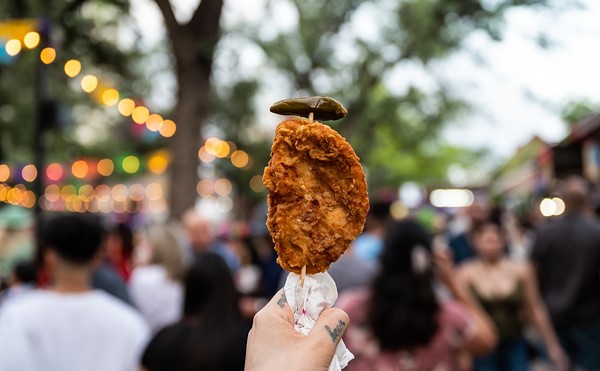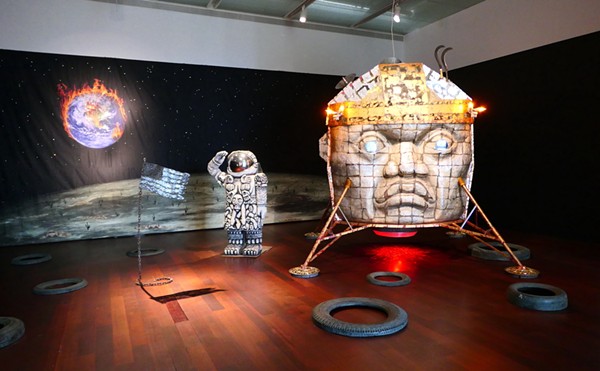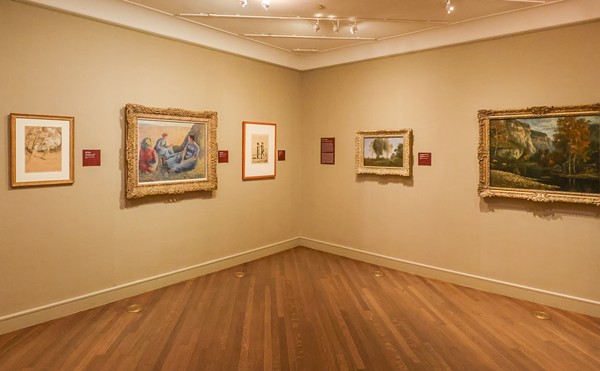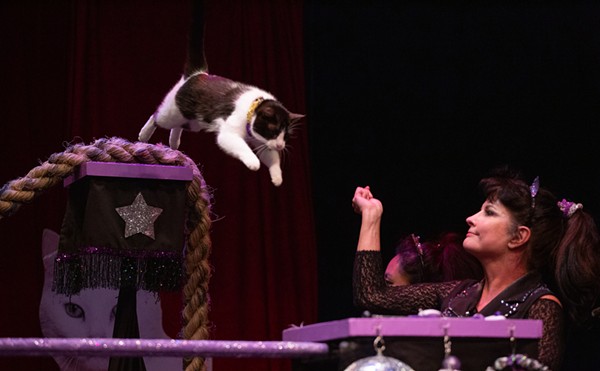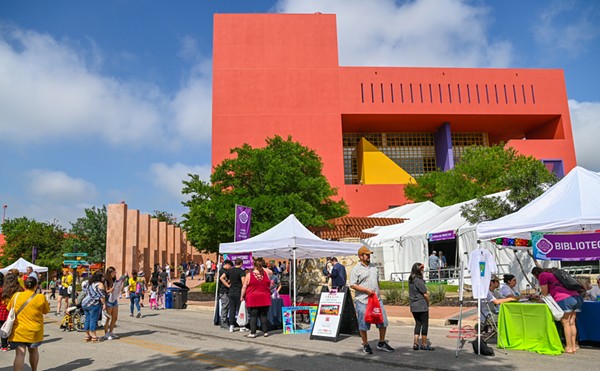Marketing often multiplies exponentially — a good ad campaign leads to coverage and recommendations in those generic city guides littering hotel lobbies and downtown pickup boxes. Which is why you think first of Fiesta Texas, Sea World, the Alamo, and god help you, Ripley’s incredible-money-evaporating machine when you think of local large-group entertainment.
Perhaps PR dollars aren’t the only reason those attractions outstrip more humble and quirkier fare, but it’s one factor (other possibilities being niche appeal and odd hours — call ahead) in the relative obscurity of the Say-town diversions I’m about to recommend for your remaining few days of summer freedom.
Wooden Nickel Historical Museum
(210) 829-1291; wooden-nickel.net
For those who recall the LB Magic Company that used to be on Broadway, not all is lost or forgotten. Many of the wooden nickels that LB made can now be found at Herb Hornung’s Wooden Nickel Historical Museum by the Botanical Garden in a remote location next to a VFW Hall. Several people I talked to who live within walking distance of the museum were unaware of its existence. Unfortunately, the same can’t be said for some untalented graffiti artists who defaced the world’s largest wooden nickel that Herb has prominently displayed outside the museum. (It’s featured in the newest edition of Ripley’s Believe it or Not!)
In addition to the wooden nickels LB left behind, Hornung has collected other examples over the years. Together they help tell the forgotten history of wooden currency. Hornung described how wooden nickels were first used in Washington State during the Depression when the banks closed and local towns needed their own money. In talking to Hornung I realized that the history of wooden nickels is still being written, for not only does he collect wooden nickels, he makes them on the 1885 2-ton cast-iron printing plate he bought from LB Magic Company.
His business, the Old Time Wooden Nickel Co., is one of five in the world that still make wooden nickels. What distinguishes Hornung’s company is the ability to print multicolored nickels with consecutive numbering. This feature has won Hornung a lion’s share of new business. I incorrectly assumed the only people still ordering wooden nickels were barbershop quartets. Not so. In fact, several states around the country hire Hornung to print wooden nickels specifically for their farmers markets to be used in lieu of plastic food-stamp cards. Because he is the only one in the world who can mint these special colored and numbered wooden coins, Hornung tells me the chances for counterfeit are zero. This retro-innovation is just the latest in the evolution of the wooden nickel. It’s comforting to know that if our current economic slump slides right into the Second Great Depression, San Antonio could survive by meeting the homemade-currency needs of South Texas and beyond.
Texas Transportation Museum
(210) 490-3554, txtransportationmuseum.org
Situated at the northwest corner of Wetmore and Wurzbach Parkway, the Texas Transportation Museum sits on a sprawling 37 acres next to McAllister Park. For kids, the museum may seem like a wonderful playground filled with larger-than-life toys. There is an extensive outdoor model train track that is one of the largest in Texas and is filled with a variety of miniature geographic and manmade features, including tunnels, bridges, and towns. The track is managed by the San Antonio Garden Railroad Engineers Society, which is not to be confused with the Alamo Model Railroad Engineers, who manage an indoor model train track in another part of the museum. Quickly, one senses that the museum is home to a spectrum of groups who share an enthusiasm for various modes of transportation.
The TTM’s centerpiece is the Longhorn and Western Railroad, which operates a full-size train on the property. Accompanying the railroad is a vintage train depot from 1913 that was rescued from Converse in the middle of the night after it was slated for destruction.
The museum is run by volunteers and enthusiasts and has an advertising budget of zero dollars, yet somehow they’ve managed to survive and make progress since the museum’s 1964 inception. A brilliant Scot named Hugh Hemphill leads the museum. Hemphill is an academic historian who’s already published one book with local Maverick Publishing and has another on the way. He says the museum’s key demographic is 6-year-old boys, which is another way of saying that the museum is targeted at families. A group of seven can visit the museum for less than $25, an outstanding deal in today’s economy.
Hemphill (jokingly) claims an occasional source of volunteers are the bored parents of repeat underage visitors, who eventually wander into the depot to chat up the staff. Some kids have grown up at the museum, he says, such as Domingo Molina, who began with an interest in the garden train track at age 5 and now in his teens has moved on to the real trains. The TTM is for families and run by families; not many other museums around town can make the same claim.
Yturri-Edmunds Historic Site
(210) 534-8237; $6, under 12 free
Located at 128 Mission Road about a block southwest of Roosevelt Park, the Yturri-Edmunds homestead is fairly hidden from sight and memory. Many historical sites in town can be classified as either of German or Spanish Missions derivation. The Y-E is neither; or perhaps, both. To add further to its mystery, historians and archeologists have been unable to confirm whether the original adobe building is from 1729 or the 1860s. If that doesn’t exert enough enigmatic pull for you, a grotto in the yard bears an inscription by an archbishop swearing there’s a ghost on the property.
After Ernestine Edmunds (daughter of Vicente Yturri) passed away in 1961, the San Antonio Conservation Society came into possession of the house, which was functioning in a fairly pristine state of anachronism, as evidenced by the kerosene lanterns still in use. Since then, the Conservation Society has researched and established its history as best it can, while adding a hodgepodge of other roughly period structures. Docent Wayne Bowden serves as official tour guide and unofficial house detective.
Photographic evidence confirms the Y-E homestead sat on the bank of the river before civil engineers re-routed its direction. An acequia can be seen on the property, yet its path leads underneath the adobe house, which is odd. The acequia isn’t very wide, which throws into question the legitimacy of the mill that was possibly built around 1820, or 1729, but most definitely reconstructed in 1972. Before Mission Concepción relocated to San Antonio from East Texas in the 1740s, the Yturri site may have served as a chapel and rectory for the area, assuming the house and mill were completed at the earlier date as Ernestine Edmunds suggests in her writings. Unraveling the mystery of the Y-E site is part of its appeal.
Visitors can also ponder significant but non-Yturri-Edmunds buildings such as the Oge Carriage House that was relocated from King William in 1964, and the one-room Postert House that originally sat on South Flores and was reconstructed in 1985. Oh, and if you’re planning to visit, please do so soon. In January, Mission Road is scheduled for improvements, which will further isolate the site, but once the road is finished, the Y-E should have a bright future as a launching point for journeys down the Mission Trail.
Barney Smith’s Toilet Seat Art Museum
(210) 824-7791
In 2006 the Department of Homeland Security slashed New York City’s anti-terror funding from $207.5 million to $124.4 million because the DHS decided, somehow, that NYC didn’t have any icons or monuments worth protecting. Instead, various folk museums around the country were deemed notable landmarks in need of protection from rogue attacks. This list designated $143 million to protect a giant lava lamp in Washington state, $12 million for the world’s largest ball of paint in Indiana, and of more interest to us in San Antonio, $10 million to protect Barney Smith’s Toilet Seat Art Museum in Alamo Heights. Against this backdrop, visiting the toilet seat museum was an imperative. To avoid doing so would be admitting to the terrorists, “You have won!”
In talking with Barney Smith, I realized he was unaware of the role his museum played in federal-budget partisan politics, but this wasn’t the first time Barney has caught national attention. He collects copies of various articles written about him and video recordings of the television shows that have featured him — Montel Williams, The View, Tom Green, to name a few. Despite the attention, Barney is humble. A retired plumber, he spends his time making artwork out of toilet seats because he enjoys entertaining visitors, not because of a desire for fame.
The garage/museum is small in size but impressive in scope. When Barney opens the museum doors, an overflow of toilet seats can be seen stretching out along the fence and onto the driveway. Inside the museum one is surrounded by walls of toilet seats stretching to the ceiling and commemorating almost every imaginable group, concept, and personality.
His technique varies from seat to seat. Employing painting, collage, and even carving, Smith’s toilet seats are small monuments to the world around him. There is a balance between local groups and national issues represented, with everything from a Tim Duncan toilet seat to one focused on, coincidentally, 9/11 and terrorism. There are 833 seats in the museum, with 834 — a tribute to the Beijing Olympics — on the way. Visitors provide Barney with inspiration for new toilet seats, often times by simply suggesting them. In this respect, Barney Smith doesn’t fit the romanticized notion of the artist searching within for inspiration. Smith instead almost exclusively works from outside material by documenting various subjects in a way that says more about the objects of his attention than him. Well, at least individually. When the toilet seats are seen as a whole, the museum takes on a singular vision that becomes specific and unique.
The best part of the museum is Smith himself. Though he is now in his late 80s, his passion and wit have not dimmed. His museum is a gift to the city, and in some ways can be seen as a historical document. Though Barney’s work is focused on everyone but himself, it is fitting that he has become an art star in his own right. Perhaps the DHS was right. •




